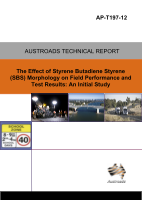Pavement

The Effect of Styrene Butadiene Styrene (SBS) Morphology on Field Performance and Test Results: An Initial Study
- Publication no: AP-T197-12
- ISBN: 978-1-921991-21-9
- Published: 28 February 2012
- PDF (free) Download
Styrene butadiene styrene (SBS) is the most commonly used polymer modified binder (PMB) type. It provides substantial performance enhancement in seals and asphalts, compared to unmodified bitumen. However, there have been field failures, and difficulties with obtaining reproducible test results. The aims of the study were to clarify how the properties of SBS binders depend on morphology, and identify factors that control morphology, use this knowledge to determine the viscoelastic properties of SBS binders in different types of field surfacing and establish whether PMB specification test procedures need to be modified.
- 1. INTRODUCTION
- 1.1. Polymer Modified Binder (PMBs)
- 1.1.1. The Use of PMBs
- 1.1.2. The Nature of Rubbers
- 1.1.3. Styrene Butadiene Styrene (SBS) Thermoplastic Rubbers
- 1.1.4. Blends of Thermoplastic Rubbers with Bitumen
- 1.2. Morphology
- 1.3. Aims of the Study
- 1.4. Research Plan Overview
- 1.4.1. Evaluation of Binder Morphology
- 1.4.2. Evaluation of Viscoelastic Properties of Seal and Asphalt Specimens
- 1.4.3. Comparison of the Morphology of Routine Test Samples with Field Morphology
- 2. REVIEW OF LITERATURE ON SBS MORPHOLOGY
- 2.1. Introduction
- 2.2. Modification Mechanism
- 2.2.1. Solubility
- 2.2.2. Separation of a Blend into Two Phases
- 2.2.3. Swelling of the Elastomer
- 2.2.4. Compatibility
- 2.2.5. Two-phase Behaviour
- 2.3. Preparation of Microscope Samples
- 2.4. Observation of Changes in Morphology
- 3. EXPERIMENTAL
- 3.1. Sample Preparation
- 3.1.1. Laboratory Prepared Samples
- 3.1.2. Commercial PMBs
- 3.2. Isothermal Storage in a Cooling Regime
- 3.3. Fluorescence Microscope Examination
- 3.3.1. Fluorescence Microscopy
- 3.3.2. Preparation of Microscope Sample
- 3.4. Dynamic Shear Rheometer (DSR) Testing
- 3.4.1. Sample Preparation
- 3.4.2. DSR Testing
- 3.4.3. Other Physical Testing
- 3.5. Fractionation Using an Iatroscan
- 4. RESULTS AND DISCUSSION
- 4.1. Effect of Conditioning Temperature on a Commercial Binder
- 4.1.1. Comparison between Drop and Freeze Sample Preparation Methods
- 4.1.2. Structures Formed
- 4.1.3. DSR Testing
- 4.1.4. Elastic Modulus and Dynamic Viscosity
- 4.2. Effect of Curing Time on Laboratory Manufactured Sample
- 4.3. Effect of Bitumen Compatibility on Morphology
- 4.3.1. Microscope Examination and DSR Testing
- 4.3.2. Softening Point Results
- 4.4. Morphology in Specification Test Samples
- 4.5. Morphology of Field Samples
- 4.5.1. Asphalt
- 4.5.2. Sprayed Seals
- 5. GENERAL DISCUSSION
- 5.1. Chemically Modified SBS Binders
- 5.2. Phase Morphology
- 5.3. Viscoelastic Properties
- 5.4. Asphalts and Seals
- 5.4.1. Asphalts
- 5.4.2. Sprayed Seals
- 5.5. Specification Tests
- 5.6. Information Required
- 5.6.1. Seal Performance
- 5.6.2. Specification Tests
- 5.6.3. Binder Morphology
- 5.6.4. Chemically Stabilised SBS Binders
- 5.6.5. Other PMBs
Related publications
Latest Pavement News
